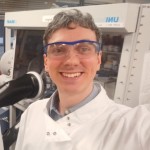
Chemistry and chemical engineering academic staff
Take a look at our chemistry and chemical engineering academic staff.
Head of school

Professor Adrian Dobbs
Head of School of Chemistry and Chemical Engineering
Academic staff

Dr Anas Alkayal
Lecturer in Organic and Practical Chemistry

Professor Esat Alpay
Emeritus Professor

Dr Bahman Amini Horri
Associate Professor of Chemical Engineering and Sustainable Energy; Leader of MSc Sustainable Energy; Fellow at the Institute for Sustainability

Dr Milan Antonijevic
Associate Professor in Pharmaceutical Sciences

Dr Lewis Baker
Senior Lecturer in Chemical and Process Engineering - Foundation Year

Dr Natalie Belsey
Associate Professor & Principal Scientist at NPL

Dr Nathaniel Bingham
Senior Lecturer in Chemistry

Dr Madeleine Bussemaker
Associate Professor in Chemical Engineering

Professor Qiong Cai
Professor in Sustainable Energy and Materials; Sustainability Fellow; Theme Leader on Chemicals for Net-Zero within the Institute for Sustainability

Dr Daniela Carta
Senior Lecturer in Physical Chemistry

Dr Franjo Cecelja
Reader

Dr Ralph Chadeesingh
Senior Teaching Fellow in Chemical Process Engineering

Professor Tao Chen
Associate Vice-President, International and Professor in Chemical Engineering

Dr Daniel Commandeur
Surrey Future Fellow

Professor Carol Crean
Professor in Physical and Materials Chemistry

Dr Ian Cunningham
Senior Lecturer in Chemistry

Dr Monica Felipe-Sotelo
Lecturer in Radiation and Analytical Chemistry

Dr Siddharth Gadkari
Lecturer in Chemical Process Engineering

Dr Vasanth Kumar Kannuchamy
Lecturer of Chemical and Process Engineering

Dr Oleksiy Klymenko
Senior Lecturer in Chemical Process Engineering

Dr Kalliopi Kousi
Lecturer of Chemical Engineering

Professor Judy Lee
Professor in Chemical and Process Engineering

Professor Guoping Lian
Professor

Dr Anh Thi Van Phan
Lecturer in Chemical Engineering

Dr Ian Riddlestone
Lecturer in Inorganic Chemistry

Dr Peter Roth
Senior Lecturer in Applied Organic/Polymer Chemistry and School Postgraduate Research Director

Dr Marco Sacchi
Associate Professor and Royal Society University Research Fellow in Physical and Computational Chemistry, Theme Leader in Sustainable Energy and Materials Research

Dr Patrick Sears
Senior Lecturer in Chemistry and Forensic Analysis

Dr Juan Daniel Sebastia Saez
Lecturer of Chemical Engineering

Dr Michael Short
Associate Professor of Process Systems Engineering

Professor Rex Thorpe
Professor of Chemical Engineering

Dr Dimitrios Tsaoulidis
Senior Lecturer in Chemical Engineering

Dr Scott Turner
Senior Lecturer in Solid State Materials, Asscoate Head of Education

Professor John Varcoe
Professor in Materials Chemistry and Associate Head of School - Research and Innovation

Dr David Watson
Senior Lecturer in Physical and Materials Chemistry and Undergraduate Admissions Tutor

Dr Daniel Whelligan
Senior Lecturer in Organic/Medicinal Chemistry

Dr James Wright
Senior Lecturer in Chemistry

Professor Charley Wu
Professor of Chemical Engineering

Dr Lei Xing
Lecturer in Digital Chemical Engineering / Fellow of Institute for Sustainability / Fellow of Institute for People-Centred AI

Professor Jin Xuan
Associate Dean (Research and Innovation)

Dr Panagiota Zarmpi
Lecturer in Pharmaceutical Sciences

Dr Donglin Zhao
Lecturer in Chemical Engineering